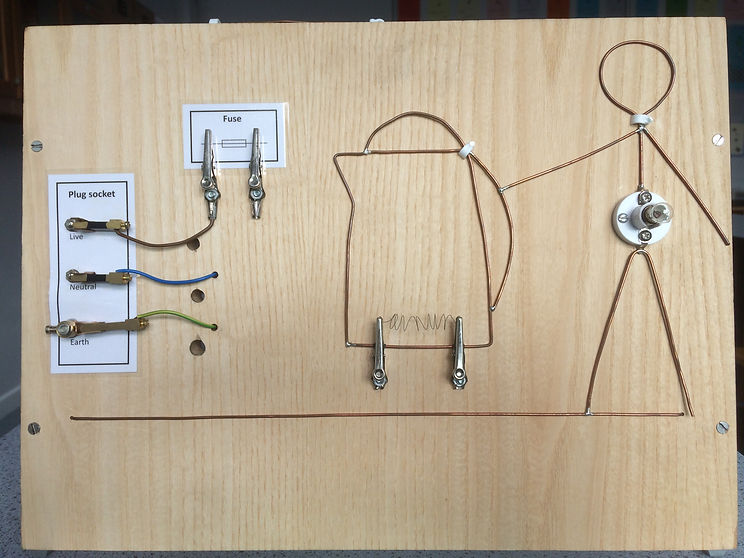
SHOWING HOW EARTH WIRES WORK
Early in my career, I had to take a fairly dry and theoretical approach to teaching about what Earth wires were and how they work. Then I came across the demonstration described below, which made it much less theoretical. It was first described in a textbook in 1970 and, as far as I can tell, either your school will have one of these (because they used that textbook back then) or they won't. I published a full description of how to build and use one to help anyone whom it had passed by, but here is a quick summary. First, here's what the pupils see:



Here's what it looks like around the back:
This is what we made ours out of:
-
Wooden board: 400 × 300 × 20 mm (though you may prefer to make a bigger version)
-
Wire to make kettle, person and ground: 16SWG Copper (diameter 1.6 mm)
-
Heating element: 30SWG NiChrome wire (diameter 0.32 mm; about 20 cm in length)
-
Fuse wire: 2 A rating (or 36SWG (0.19 mm diameter) Copper wire)
-
Lamp: 12 V, 0.1 A rating, mounted in a suitable holder
-
The plug pins are simply extracted from an old mains plug. However, if I were making one again, I would try to use an actual old plug and surface-mounted socket to make it mirror reality more clearly.
Method:
-
Connect the sockets on the back to a normal school 12V supply.
-
Disconnect the Earth pin from the 'plug', switch on the supply and turn up until the kettle 'element' glows.
-
Using a suitable conductor (a screwdriver works nicely), force a short between the Live end of the element to the body of the kettle. The lightbulb in the person will light up, showing they are receiving an electric shock:
4. Having shown how a fuse alone will not protect the user from electric shock, reconnect the Earth pin and repeat the short. This time, you should find the fuse melts immediately and the lightbulb does not have chance to light, showing that the person is kept safe and the appliance is now isolated from the supply.
Done well, this can bring home the way Earth wires work in conjunction with fuses to keep us safe in a much more direct and memorable way than simply reciting an explanation.
Harrison M (2017) Demonstrating Earth connections and fuses working together. Physics Education 52(2), 023008